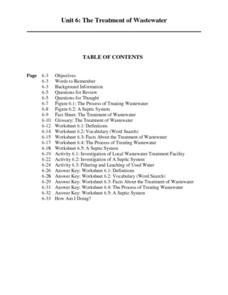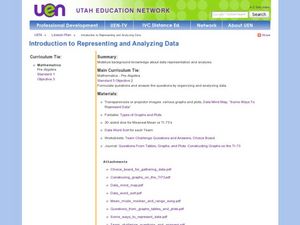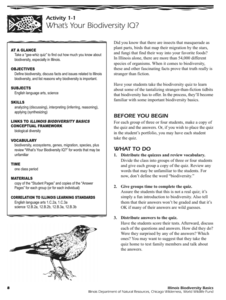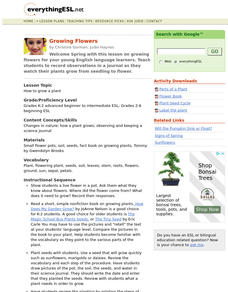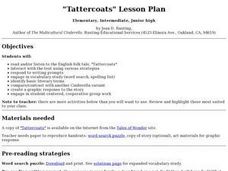Curated OER
Canoe and Kayak
Students explore canoes and kayaks. In this canoe and kayak lesson, students research the history, parts, and sport of the canoe and kayak. Students then practice how to use a paddle for each boat, and go on a field trip in order to use...
Curated OER
The Treatment of Wastewater
Learners, through a series of lessons, study the various processes of treating wastewater. They participate in discussion and complete various worksheets and a hands-on activity, in which they observe the processes of filtration and...
Curated OER
Learning About Animal Shelters for Earth Day
Students explore habitats. in this ecology and animal habitat lesson, students listen to the book A House is a House for Me by Mary Ann Hoberman. Students discuss the basic needs of animals and go on a nature walk to observe animal...
Curated OER
Writing Myths
Learners read and write myths. In this world mythology activity, students read and analyze myths from various cultures and then recognize their attributes as they write their own myths that explain natural phenomena.
Curated OER
Mexico's Day of the Dead
Students explore global culture by researching a Mexican holiday. In this Day of the Dead lesson, students read assigned text which discusses the view of death in several different cultures including the U.S. and Mexico. Students write a...
Curated OER
A Day in the Life of a Homeless Person
Learners examine the day in the life of a homeless person. In this humanitarian lesson, students examine the life of a homeless person while discovering the importance of social justice in our society.
Curated OER
Self-Assessment: Habits of Effective Readers, Writers, Speakers, Listeners, and Viewers
Fifth graders study how to read fluently. In this reading lesson, 5th graders practice reading and recording any miscues. Students time each other and graph their progress each day.
Curated OER
Retelling and Summarizing
Having students use a rubric to score a piece of writing is an excellent practice. They read a passage titled, "Firefighters," and discuss different summaries that were written about it. They evaluate several summaries then score them...
Curated OER
Tell a Ton of Tall Tales
Elementary schoolers read many tall tales. They create their own tall tale about a specific event of their choosing. They must act the part of the author. This well-designed lesson takes three class sessions to complete, and is...
Curated OER
Introduction to Representing and Analyzing Data
Represent data graphically. Allow your class to explore different methods of representing data. They create foldables, sing songs, and play a dice game to reinforce the measures of central tendency.
HealthTeacher
Get More Sleep
Help learners identify habits that interfere with sleep and to understand the importance of adequate rest and its impact on not only physical health, but also emotional wellbeing.
Berkshire Museum
Where’s the Water?: Acting Out Science Cycles
Young scientists transform themselves into rivers, oceans, clouds, and drops of water in order to explore the water cycle. After assigning and explaining to students their different roles in the activity, the teacher reads aloud a...
Achieve3000
Context Clues and Idioms
Kids practice using five types of context clues (definition, synonym, antonym, example, and general) to decode idiomatic language.
Wordpress
Greetings - How and Where Might We Greet Someone Using Spanish?
Use the Total Physical Response (TPR) strategy to practice Spanish greetings as well as where and who question prompts. Comprised of five days, this short unit is taught completely in Spanish with call-and-response exercises, group...
Curated OER
Literature-Based Skill Building: Freak the Mighty Chapter Three
Have your 5th or 6th graders read Freak the Mighty? Check their reading comprehension with this online worksheet. They answer 15 different questions based on chapter 3: American Flyer.
Illinois Department of Natural Resources
Section One: What is Biodiversity?
Four intriguing and scientific activities invite learners to explore the natural resources of their town. The activities cover concepts such as genetic traits, organizing species in a taxonomy, the differences between different species...
Curated OER
Camel Container: Ceramics
Play with clay while building finger dexterity and important sculpting techniques. Learners make camel containers while they practice throwing and molding clay. Fun camel facts make this an interdisciplinary art lesson.
Knoxville Art Museum
Lee Walton: Codes in Drawings
Familiar with the systems-based sports drawing of experimental artist Lee Walton? If so, this drawing exercise if for you. Young artists observe an activity over time, develop a coded language for the activity, and then draw a...
Southern Poverty Law Center
Evaluating Reliable Sources
A lesson plan instills the importance of locating reliable sources. Scholars are challenged to locate digital sources, analyze their reliability, search for any bias, and identify frequently found problems that make a source unusable.
Curated OER
Making Good Money Choices
Young scholars identify the needs of their community. In this communities instructional activity, students use a decision-making model worksheet to determine what community service project they should donate to. Young scholars count the...
Curated OER
Transportation Math
Students practice their problem solving skills. In this addition and subtraction lesson, students solve story problems regarding the delivery of consumer goods.
Curated OER
Growing Flowers
Students grow flowers from seeds. They plant quick-growing seeds in a flower pot and consider what a seed needs to grow. They observe and record the growth of the planted seeds in science journals.
Curated OER
Choosing Plymouth - Pilgrim Study Unit
Students identify the principal physical features the Pilgrims considered when choosing the location of Plymouth. They create a postcard to send to a friend in Europe as if they were a Pilgrim; illustrating one aspect of the settling in...
Curated OER
Tattercoats
Students read the English folktale, "Tattercoats," identify basic literary terms, and respond to writing prompts. They compare and contrast with another Cinderella story version and create a graphic response to the story.



